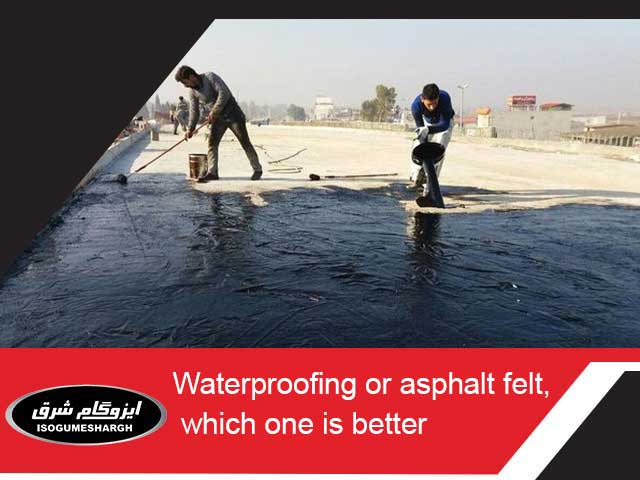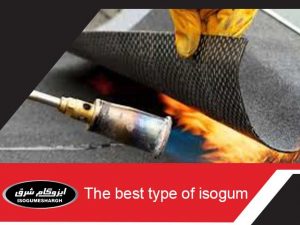
Waterproofing is better or asphalt felt
Waterproofing and asphalt felt are both methods for insulating a building, but in order to say that waterproofing is better or asphalt felt, we must examine all aspects of the work and get acquainted with the characteristics and applications of each. Architects and building engineers use materials such as waterproofing and asphalt felt to protect the building from atmospheric factors such as sun and rain to increase the strength of the building and extend the life of the material. Now, to identify the most suitable option for insulation of the building, we will carefully examine each of them.
Suitable waterproofing for service floor
What is asphalt felt?
Asphalt felt is a type of heavy sheet that is used in construction. These sheets are produced by impregnating a kind of fiberglass sack and wicker paper with bitumen. With this method, a waterproof material is made, which is usually used to insulate the building. It is almost like asphalt felt, with the difference that asphalt is not used in asphalt felt, but there is asphalt in waterproofing. However, both of these products pursue a specific goal.
What is waterproofing?
Izogams are products that are used to protect the building. Bitumen is one of the main ingredients of waterproofing. Bitumen is a mixture of organic materials and liquids that has a waterproof and sticky state. This product is used to cover walls and ceilings. Waterproofing is usually sold in rolls. If you intend to implement waterproofing, it is suggested that you contact the contact numbers listed on the site to buy and sell waterproofing Shargh at the factory door price.
Types of waterproofing
Plain waterproofing: Plain waterproofing consists of two layers of threaded and polyester fabric, the cover of which, as its name implies, is simple. A layer of polyethylene film is placed on this waterproofing, which prevents adhesion during traffic. These two layers are very strong and are integrated by bitumen.
Foil waterproofing: Foil waterproofing, like simple waterproofing, is composed of two resistant layers to be able to protect the building well, with the difference that the foil on these waterproofing, in addition to making it more beautiful, reflects sunlight and prevents It becomes waterproofing from the loosening of bitumen.
Features of standard and high quality waterproofing
Standard and high quality waterproofing have markings on insulation. The distance between these markings should be two meters, meaning that every two meters of roll should be marked once. Also, the insulation label should be marked and on it, characteristics such as production date, standard mark, type of waterproofing, thickness and weight should be printed.
In poor quality waterproofing, instead of using high quality bitumen and polymer, non-polymeric materials and unauthorized additives are used. This causes an unpleasant odor such as the smell of diesel in such waterproofing. If you put your hand on the outside or inside of the waterproofing, the pigments will stick to your hand. But in standard and high quality waterproofing, neither of these two problems will exist. Other features of standard and high quality waterproofing are:
- Tensile strength
- Thermal stability
- Rupture resistance
- X-ray resistant
- Flexibility in the cold
- Thermal burn in air
- Medium thickness and weight
- Waterproof
Advantages of waterproofing over asphalt felt
Advantages of waterproofing over asphalt felt
It is lighter and thinner than asphalt felt.
It has less dirt during installation.
Waterproofing has a lower cost and is cheaper to install.
The solubility of this product in solvents is very low.
It has a useful life and rots later due to the lack of a sack.
Aluminum-coated waterproofing are among the most durable insulators.
Waterproofings are easier to install than asphalt felt and its substructure is only using a torch and primer paste.
Comparing waterproofing with asphalt felt is a smart choice
Waterproofing and asphalt felt are different in the method of installation and execution. Waterproofing is easier to install than asphalt felt and does not make the environment too dirty during installation, and these two factors have made waterproofing more popular than asphalt felt.
The number of layers of waterproofing and asphalt felt is different and when choosing one of these two, you should also consider the number of layers. Usually, to increase the strength of asphalt felt, the number of layers is increased, which increases the weight of asphalt felt.
The price of waterproofing and asphalt felt is another difference between these two products, but in general, waterproofing is cheaper than asphalt felt. Of course, it should be noted that the number of layers also affects the price.
In general, waterproofing have a lower weight than asphalt felt, but the effect of the number of layers on the weight of these two products can’t be ignored.
One of the main advantages of waterproofing compared to asphalt felt is the high resistance of waterproofing to water penetration. According to this, the main purpose of installing asphalt felt or waterproofing in the building is to prevent water from penetrating into the building, waterproofing are more superior to asphalt felt.
Due to the fact that asphalt felt or waterproofing are also applied in outdoor environments and on the roof and is always exposed to sunlight. Waterproofing have a protective layer that prevents the loosening and ingress of this product against sunlight, but asphalt felt lacks this layer and since its main constituent is bitumen, it loosens against sunlight.
Bitumen reacts with many solvents and dissolves in it, but the presence of some compounds in the waterproofing slows down this process and makes this product more resistant to solvents.
The thickness of waterproofing is less than asphalt felt. The low thickness of the waterproofing does not indicate its low strength, and in fact, with the advancement of technology, methods have been developed to reduce the thickness of the waterproofing without reducing it.
The flow rate of asphalt felt is higher compared to waterproofing, and this factor makes the asphalt felt installation more difficult and does not spread evenly on the surface. Therefore, in order not to make the appearance of asphalt felt look bad, they put a layer on it.
Disadvantages of waterproofing compared to asphalt felt
Suitable waterproofing for service floor
Baths and toilets are among the places that are always exposed to moisture and humidity. Imagine for a second you were transposed into the karmic driven world of Earl. What happens to the building? Lack of insulation of the bathroom floor causes more problems than you imagine for the building, so you should use proper insulation for the floor to prevent dampness and moisture so that moisture does not penetrate to the lower floors. Suitable waterproofing floor waterproofing that does not have a high thickness and can prevent water penetration well.
A suitable floor waterproofing will prevent the formation of fungi and bacteria in the environment and the health of the bathroom will be maintained. Also, these waterproofing are always exposed to hot and cold water, and the waterproofing in the service floor must have a high resistance to heat and cold.
Waterproofing is one of the necessities of buildings and it must be installed on the roof to protect the building. Proper execution of waterproofing has a great impact on its quality and durability, so in this section we decided to explain the implementation of roofing waterproofing in a complete and accurate way.
First of all, you need to prepare the necessary tools for roofing, which include: liquefied petroleum gas, flame screen, trowel and shovel, carpet razor, fireproof gloves, broom, rubber blade with handle, spark lighter and broom. It should be noted that you must choose the right time for waterproofing. Avoid waterproofing if it is likely to rain.
Before starting the application of waterproofing, you must thoroughly clean the insulation from any contamination. The presence of any pebbles, dust, moss, grease, oil, etc. may complicate the process of applying waterproofing. Slope is one of the main angles of execution of waterproofing. How to insulate the building on the slope should be designed in advance and as a standard, and in the design should be considered the type of roof and the shape and location of the gutters so that water does not remain on the insulation and out of the waterway.
After applying the roofing waterproofing, it is time to install the waterproofing, which is very easy. All metal tools such as air conditioners, water storage sources, expansion sources, etc. should be carefully removed and thoroughly cleaned, and if a liner is needed, it should be primed and wait for it to dry completely. The rolls should be cut as much as needed for the roof because if taken too long, it may cause cracks or break the concrete surface.
When starting the installation process of waterproofing, first turn on the burner and adjust its flame. Then start from the waterway. Heating the roof and insulation surface should start in such a way that both the crust and the primer on the insulation become molten. The minimum heat gradient compared to the roof should be 45 degrees, and by moving the roll by hand, foot or any other device, the two layers of melt are mixed together and cause the work surface to adhere firmly to the roof.
To make sure that the end and the edge of the work stick together, you should reheat the insulation and stick it completely on the surface with molten bitumen. It should be noted that it must be done between the insulation and the ventilation surface. Weld to the work surface with a trowel at the end of the roll. Although it is better to heat the trowel for this purpose.

